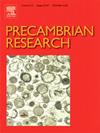安哥拉西南地盾前中元古代地壳格架和中元古代演化:库内内杂岩及其周围基底的构造、地球化学和同位素研究
IF 3.2
2区 地球科学
Q2 GEOSCIENCES, MULTIDISCIPLINARY
引用次数: 0
摘要
安哥拉地盾西南部拥有地球上最大的中元古代块状斜长岩杂岩(面积达53,500平方公里)——库内杂岩(KC)。这个复合体是长寿命(~ 200 Ma)的聚结岩浆脉冲幕式侵位的结果。PLANAGEO项目最近获得的多学科数据,极大地增强了我们对安哥拉地盾西南部前寒武纪地壳框架的认识。综合多同位素、构造和地球物理数据显示,安哥拉地盾西南部独特的地壳带明显影响了KC在弧后环境中的位置。KC脉冲的时空排列表明岩浆在一个复杂的收缩机制下向西迁移,其中包括大型走滑系统。中元古代大部分时间的构造-热活动是由一个长期而广泛的增生造山带造成的。地壳减薄和同位素不均匀下地壳源通过地幔上升流的部分熔融促进了与KC同时期的幕式长英质岩浆活动。辉长岩-斜长岩中明显存在地壳污染过程,表明在上升过程中地幔交代作用以及与围岩和花岗岩熔体的相互作用,受到侧向动力的上升流作用。覆盖KC的1.26 Ga粗大变质沉积层序的沉积,以及1.23 ~ 1.07 Ga岩石圈下活动和幔源岩浆活动,表明晚中元古代由挤压向伸展转变。与非洲和巴西对应的其他中元古代单元的区域对比表明,尽管构造背景可能存在差异,但它们具有共同的地质演化。这些发现支持了刚果克拉通西南部中元古代演化的精细地质模型。本文章由计算机程序翻译,如有差异,请以英文原文为准。

Pre-Mesoproterozoic crustal framework and Mesoproterozoic evolution of the SW Angolan Shield: structural, geochemical, and isotopic insights from the Kunene Complex and surrounding basement
The southwestern Angolan Shield hosts the Earth’s largest Mesoproterozoic massif-type anorthosite complex (up to 53,500 km2), the Kunene Complex (KC). This complex is the result of a long-lived (∼200 Ma) episodic emplacement of coalescent magmatic pulses. The recent acquisition of multidisciplinary data during the PLANAGEO project has significantly enhanced our understanding of the Precambrian crustal framework from the southwestern Angolan Shield. Combined multi-isotope, structural and geophysical data reveals distinctive crustal zones in the southwestern Angolan Shield that clearly influenced KC’s emplacement within a back-arc setting. The spatio-temporal arrangement of KC pulses suggests westwards magma migration within a complex contractional regime involving large strike-slip systems. A long-lasting and extensive accretionary orogen was responsible for the tectono-thermal activity recorded during most of the Mesoproterozoic. Crustal thinning and partial melting of isotopically heterogeneous lower-crustal sources through mantle upwelling promoted the episodic felsic magmatism contemporaneous with the KC. Crustal contamination processes are evident in gabbro-anorthosites, indicating mantle metasomatism and interaction with wall-rocks and granite melts during ascent, upwelled by lateral-driven forces. Deposition of extensive metasedimentary sequences (<1.26 Ga) covering the KC, along with 1.23–1.07 Ga sublithospheric and mantle-derived magmatism, indicate a shift from a compressional to an extensional regime during late-Mesoproterozoic times. Regional correlations with other Mesoproterozoic units in African and Brazilian counterparts suggest a shared geological evolution, despite potential differences in tectonic setting. These findings supports a refined geological model for the Mesoproterozoic evolution of the southwestern part of the Congo Craton.
求助全文
通过发布文献求助,成功后即可免费获取论文全文。
去求助
来源期刊

Precambrian Research
地学-地球科学综合
CiteScore
7.20
自引率
28.90%
发文量
325
审稿时长
12 months
期刊介绍:
Precambrian Research publishes studies on all aspects of the early stages of the composition, structure and evolution of the Earth and its planetary neighbours. With a focus on process-oriented and comparative studies, it covers, but is not restricted to, subjects such as:
(1) Chemical, biological, biochemical and cosmochemical evolution; the origin of life; the evolution of the oceans and atmosphere; the early fossil record; palaeobiology;
(2) Geochronology and isotope and elemental geochemistry;
(3) Precambrian mineral deposits;
(4) Geophysical aspects of the early Earth and Precambrian terrains;
(5) Nature, formation and evolution of the Precambrian lithosphere and mantle including magmatic, depositional, metamorphic and tectonic processes.
In addition, the editors particularly welcome integrated process-oriented studies that involve a combination of the above fields and comparative studies that demonstrate the effect of Precambrian evolution on Phanerozoic earth system processes.
Regional and localised studies of Precambrian phenomena are considered appropriate only when the detail and quality allow illustration of a wider process, or when significant gaps in basic knowledge of a particular area can be filled.
 求助内容:
求助内容: 应助结果提醒方式:
应助结果提醒方式:


